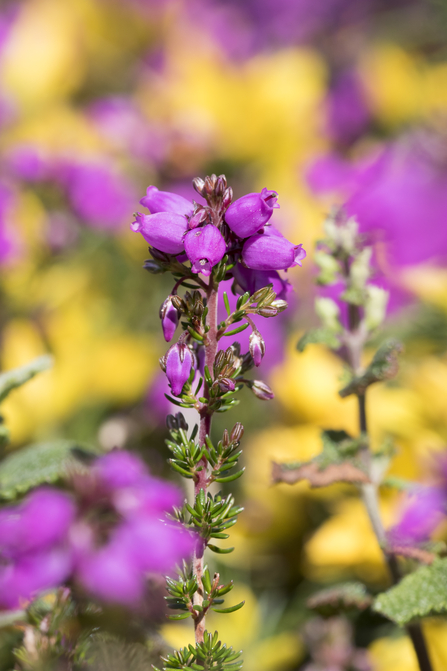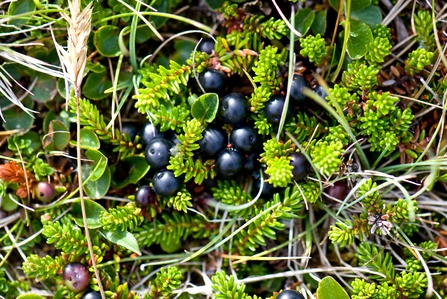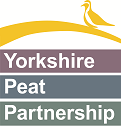While sphagnum moss is happiest in the wettest, coldest time of the year, other species flourish in a milder climate. One of these groups found on Yorkshire’s bogs is dwarf shrubs. This was my first summer on Yorkshire’s peatlands and I found dwarf shrubs to be an unexpected delight. Whilst in winter most are plain beings with woody stems and evergreen leaves, in summer they come alive to scatter the bog with colour and much needed resources. They all have their own unique qualities to add to the mosaic that is a summer bog.
The colours of a summer bog
Dwarf shrub forest © Beth Thomas
Dwarf Shrubs
Walking across a peat bog in summer is a wonderful thing, but it’s also not the easiest. This is usually down to our friends the dwarf shrubs. Although their presence is extremely valued by the team at YPP, the work out they provide your legs is one I have a love hate relationship with. They create an uneven, bumpy landscape with no way of knowing when your foot might hit not-so-solid ground. A walk across a peatland requires a lot of balance, careful planning and watching your feet and in doing so, you see the variety of dwarf shrubs adding to your difficulties.
Dwarf shrubs are characteristic of Yorkshire’s uplands; usually below knee height, these acid-loving shrubs are intertwined within the landscape. The first burst of colour you will see is the pink and purple of heather bells from June through till October. Seen from miles away, bell heather is a signature species of the uplands, providing cover and perches for upland birds. Meadow pipits enjoy dive bombing about in the heather, a disgruntled snipe will usually fly out at the last minute, and chicks of all species enjoy the security of the cover heather provides.

Bell heather Erica cinerea © Chris Lawrence
Peatland insects, however, prefer the blues and reds of bilberry, cowberry, and cranberry.
Bilberry bumblebees or Bombus monticola - what a fabulous Latin name! - are known for the queen’s love of bilberry’s red bell flowers. The flowers are a crucial part of the queen’s spring diet when she emerges from hibernation to start that year’s colony. The bilberry bumble bee has seen decline due to habitat loss; it relies on living at a higher altitude with lower temperatures. Due to climate change and an increase in temperatures the bee is now nationally scarce.
Bilberry is also a favourite of a hungry YPP employee; unlike the queen bee, though, we prefer the black-blue berries that appear in July.
Manchester treble bar moth, despite its Lancastrian name, is found in Yorkshire as it cannot resist the supply of berries for its caterpillars. Reddish with a yellowish green spiracular stripe, the caterpillar favours upland berries. Cowberry has large round green leaves with a waxy look to them. White bell flowers appear in May and disappear after June to make way for large red berries, a favourite of the caterpillars. Another temptation for the treble is cranberry, which is found trailing across sphagnum hummocks with its little red berries interspersed.
Green hairstreak caterpillar also joins the race across the bog to find the berries that can also be used to make medicine, jams and flavour an alcoholic beverage or two.
Crowberry is said to be so widespread in the northern hemisphere due to its appeal to migrating birds. It is distinguished by its tiny green leaf, which characteristically has a pale stripe running up the underside. Little pink flowers hide amongst the leaves to be replaced by dark blue berries in late summer. Aptly named the crow’s berry, it is enjoyed by crows but also curlews, doves, pheasants, and gulls.

Crowberry Empetrum nigrum © Thomas Quine CC BY-SA 2.0 Deed | Attribution-ShareAlike 2.0 Generic | Creative Commons
The importance of a Dwarf shrub
Getting to see and learn about Yorkshires uplands this year has further proven to me that this habitat is an essential one, with dwarf shrubs being an integral part of a peatland’s diversity.
The support a dwarf shrub provides in habitat, food and YPP’s employee fitness is an important part of a functioning bog and restoration team. Without these characters a lot of species would suffer and decline, as some are. The work done by Yorkshire Peat Partnership to maintain and increase this habitat by restoring ideal conditions and plug planting will benefit the many species that rely on it.
Don’t underestimate the importance of a dwarf shrub!





